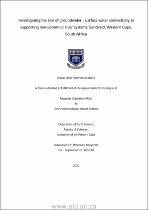| dc.description.abstract | Non-perennial rivers are characterised by a discontinuous and variable hydrological flow regime which may retreat to form isolated pools along the watercourse during prolonged dry periods. The resulting spatio-temporal variability in hydrological characteristics provides support for a variety of ecological habitats which promote species richness and biodiversity. It is well established that groundwater may offer flow supplementation to perennial river flow throughout the year as baseflow, while fewer authors have unpacked the nuances of the importance of groundwater in dynamics of water persistence and the conditions that determine non-perennial pool reoccurrence. This study explores river-aquifer interaction of the Verlorenvlei catchment within the Western Cape Province of South Africa as a case study in order to create an improved hydrogeological understanding of groundwater’s role in non-perennial rivers to improve of water management practices. A multi-method approach was designed to fulfil this aim. In addition to desktop literature review and in-field sampling of water for environmental tracers, a water presence, groundwater level, and geophysical survey was conducted in order to develop a conceptual understanding of the multi-scale interaction occurring within the Verlorenvlei basin. Results of the isotopic and chemical analysis of water sources revealed the water origin and groundwater flow dynamics for the Verlorenvlei. The contribution of groundwater from Table Mountain Group related, fault-driven flow to the groundwater balance of the Verlorenvlei creates regional gaining conditions. Local gaining conditions within the Verlorenvlei river are created through lateral input of upwelling groundwater which moves downgradient with the topography as evidenced by the hydrogeological and geophysical survey. Using the Verlorenvlei as a case study, a contribution is made to the knowledge of the role of groundwater in non-perennial rivers. The results presented in this study indicate that where basin hydrogeology allows, groundwater may play an important role in the supply of water to non-perennial pools, especially during periods of minimal rainfall. The interaction mechanisms of this groundwater contribution within non-perennial rivers are site specific and spatially variable. Basin hydrogeology, subsurface stratigraphy and water availability are key limiting factors to interaction in non-perennial rivers. Future research aimed at generating robust information on discrete zones of water presence along non-perennial rivers may allow for better assessment of the potential vulnerability of these areas to water loss. Where these areas are fed by groundwater, to accommodate for their vulnerability, groundwater capture maps may allow for investigation of the local impact of groundwater use on these areas. | en_US |

